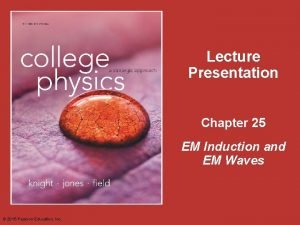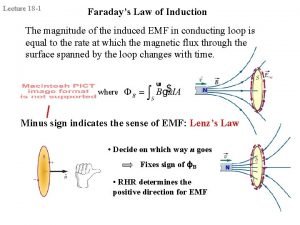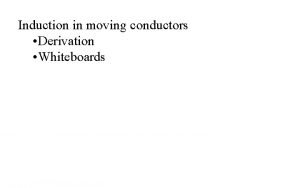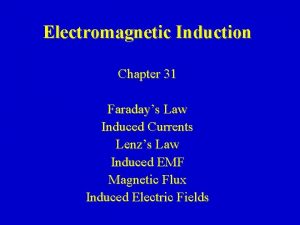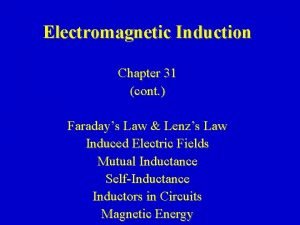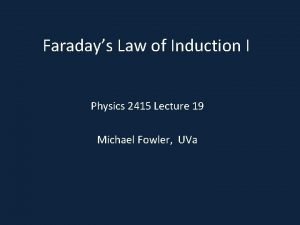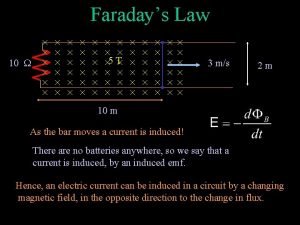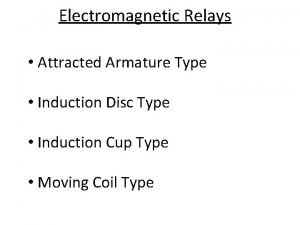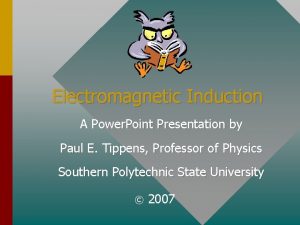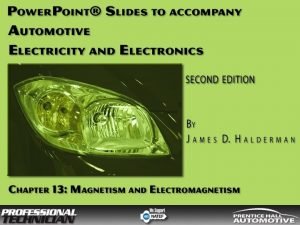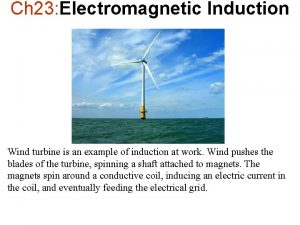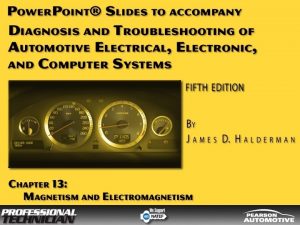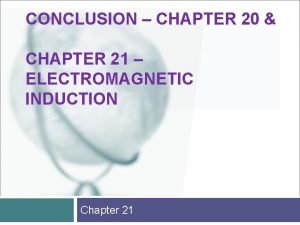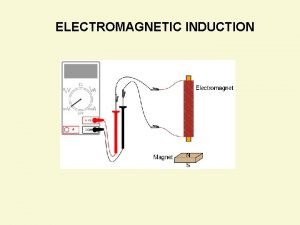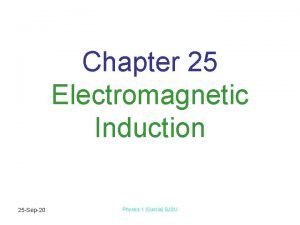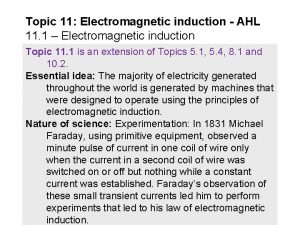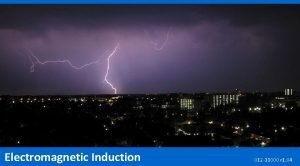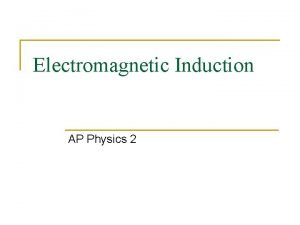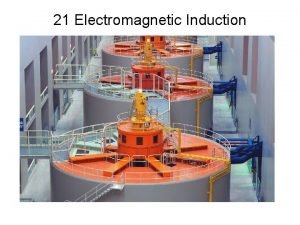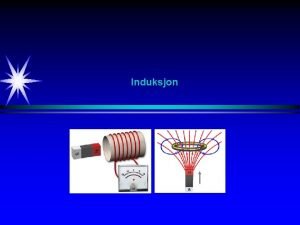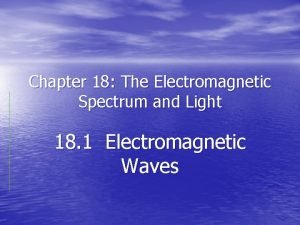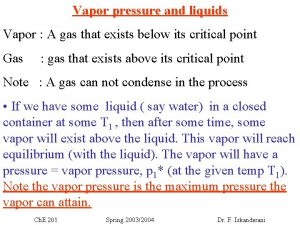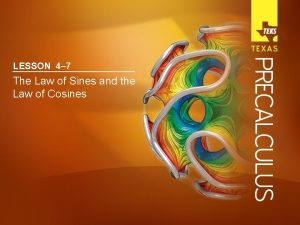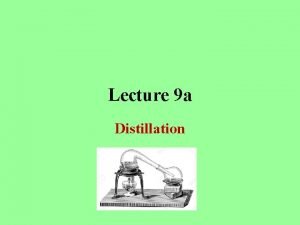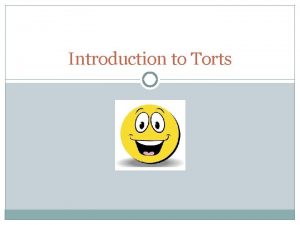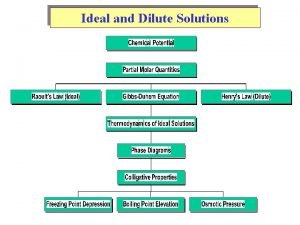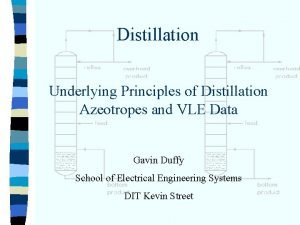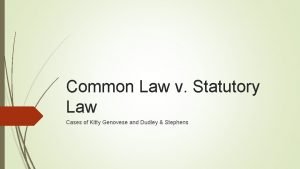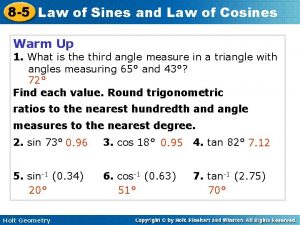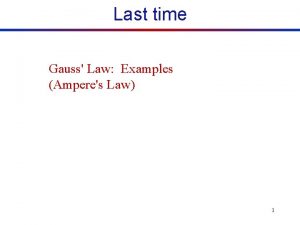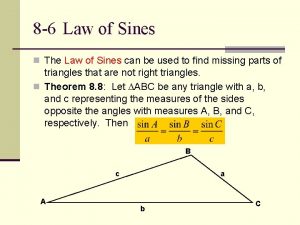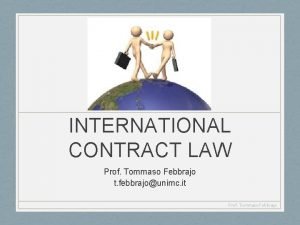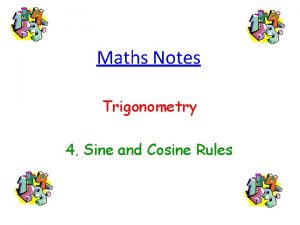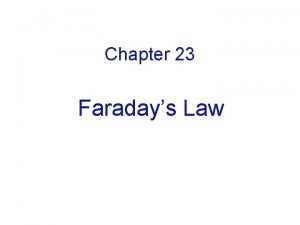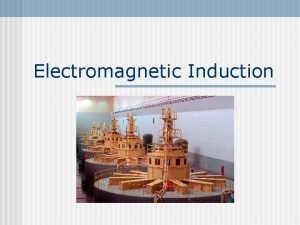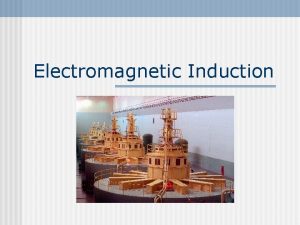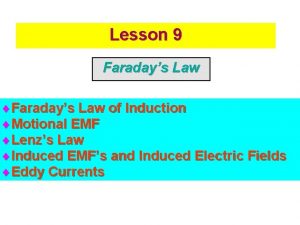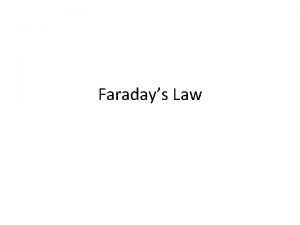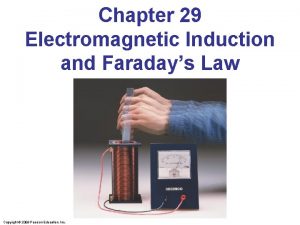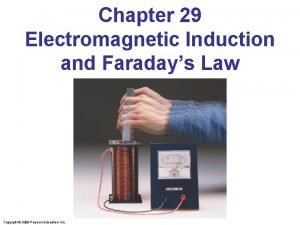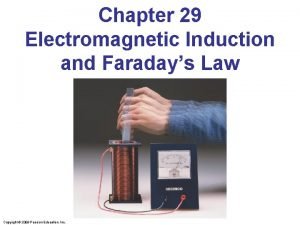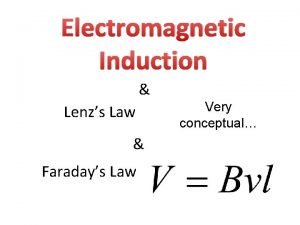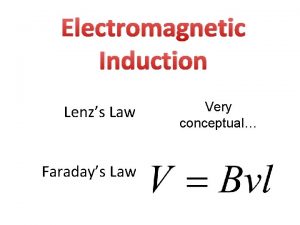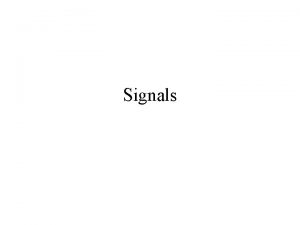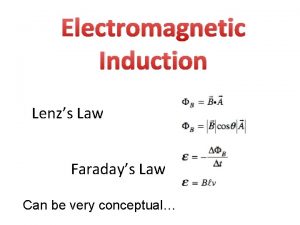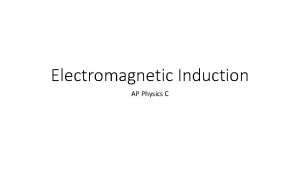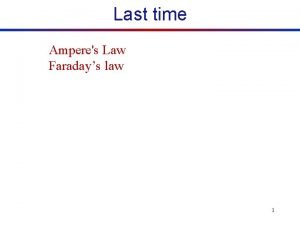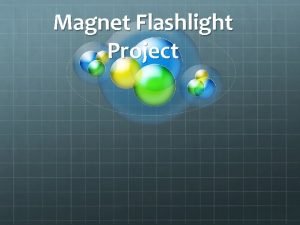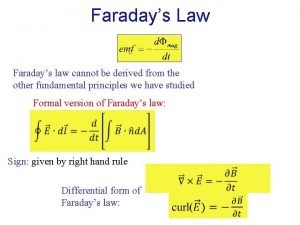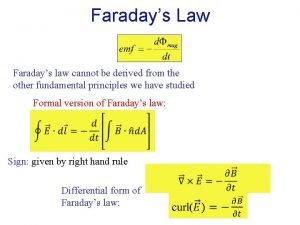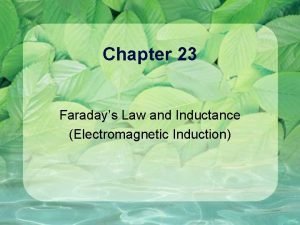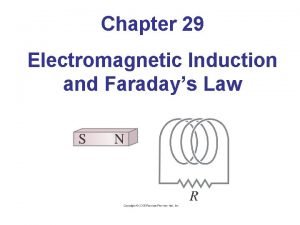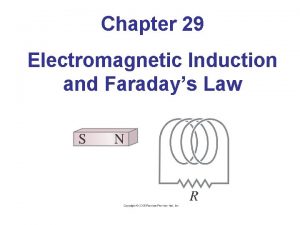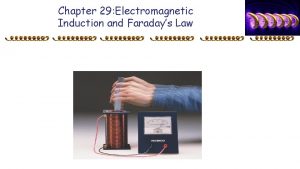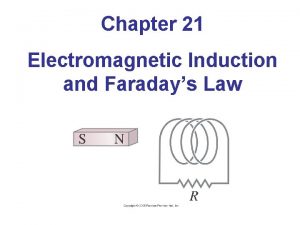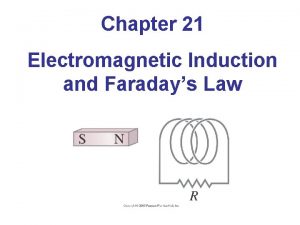Chapter 29 Electromagnetic Induction and Faradays Law Copyright















































- Slides: 47

Chapter 29 Electromagnetic Induction and Faraday’s Law Copyright © 2009 Pearson Education, Inc.

Units of Chapter 29 • Induced EMF • Faraday’s Law of Induction; Lenz’s Law • EMF Induced in a Moving Conductor • Electric Generators • Back EMF and Counter Torque; Eddy Currents Copyright © 2009 Pearson Education, Inc.

Units of Chapter 29 • Transformers and Transmission of Power • A Changing Magnetic Flux Produces an Electric Field • Applications of Induction: Sound Systems, Computer Memory, Seismograph, GFCI Copyright © 2009 Pearson Education, Inc.

29 -1 Induced EMF Almost 200 years ago, Faraday looked for evidence that a magnetic field would induce an electric current with this apparatus: Copyright © 2009 Pearson Education, Inc.

29 -1 Induced EMF He found no evidence when the current was steady, but did see a current induced when the switch was turned on or off. Copyright © 2009 Pearson Education, Inc.

29 -1 Induced EMF Therefore, a changing magnetic field induces an emf. Faraday’s experiment used a magnetic field that was changing because the current producing it was changing; the previous graphic shows a magnetic field that is changing because the magnet is moving. Copyright © 2009 Pearson Education, Inc.

29 -2 Faraday’s Law of Induction The induced emf in a wire loop is proportional to the rate of change of magnetic flux through the loop. Magnetic flux: Unit of magnetic flux: weber, Wb: 1 Wb = 1 T·m 2. Copyright © 2009 Pearson Education, Inc.

29 -2 Faraday’s Law of Induction This drawing shows the variables in the flux equation: Copyright © 2009 Pearson Education, Inc.

29 -2 Faraday’s Law of Induction The magnetic flux is analogous to the electric flux – it is proportional to the total number of magnetic field lines passing through the loop. Copyright © 2009 Pearson Education, Inc.

29 -2 Faraday’s Law of Induction Conceptual Example 29 -1: Determining flux. A square loop of wire encloses area A 1. A uniform magnetic field B perpendicular to the loop extends over the area A 2. What is the magnetic flux through the loop A 1? Copyright © 2009 Pearson Education, Inc.

29 -2 Faraday’s Law of Induction Faraday’s law of induction: the emf induced in a circuit is equal to the rate of change of magnetic flux through the circuit: or Copyright © 2009 Pearson Education, Inc.

29 -2 Faraday’s Law of Induction Example 29 -2: A loop of wire in a magnetic field. A square loop of wire of side l = 5. 0 cm is in a uniform magnetic field B = 0. 16 T. What is the magnetic flux in the loop (a) when B is perpendicular to the face of the loop and (b) when B is at an angle of 30° to the area A of the loop? (c) What is the magnitude of the average current in the loop if it has a resistance of 0. 012 Ω and it is rotated from position (b) to position (a) in 0. 14 s? Copyright © 2009 Pearson Education, Inc.

Concep. Test 29. 2 a Moving Bar Magnet I If a north pole moves toward the 1) clockwise loop from above the page, in what 2) counterclockwise direction is the induced current? 3) no induced current

Concep. Test 29. 2 a Moving Bar Magnet I If a north pole moves toward the 1) clockwise loop from above the page, in what 2) counterclockwise direction is the induced current? 3) no induced current The magnetic field of the moving bar magnet is pointing into the page and getting larger as the magnet moves closer to the loop. Thus the induced magnetic field has to point out of the page A counterclockwise induced current will give just such an induced magnetic field. Follow-up: What happens if the magnet is stationary but the loop moves?

Concep. Test 29. 2 b Moving Bar Magnet II If a north pole moves toward 1) clockwise the loop in the plane of the 2) counterclockwise page, in what direction is the 3) no induced current?

Concep. Test 29. 2 b Moving Bar Magnet II If a north pole moves toward 1) clockwise the loop in the plane of the 2) counterclockwise page, in what direction is the 3) no induced current? Since the magnet is moving parallel to the loop, there is no magnetic flux through the loop Thus the induced current is zero

29 -2 Faraday’s Law of Induction; Lenz’s Law The minus sign gives the direction of the induced emf: A current produced by an induced emf moves in a direction so that the magnetic field it produces tends to restore the changed field. or: An induced emf is always in a direction that opposes the original change in flux that caused it. Copyright © 2009 Pearson Education, Inc.

29 -2 Faraday’s Law of Induction; Lenz’s Law Magnetic flux will change if the area of the loop changes. Copyright © 2009 Pearson Education, Inc.

29 -2 Faraday’s Law of Induction; Lenz’s Law Magnetic flux will change if the angle between the loop and the field changes. Copyright © 2009 Pearson Education, Inc.

29 -2 Faraday’s Law of Induction; Lenz’s Law Conceptual Example 29 -3: Induction stove. In an induction stove, an ac current exists in a coil that is the “burner” (a burner that never gets hot). Why will it heat a metal pan but not a glass container? Copyright © 2009 Pearson Education, Inc.

29 -2 Faraday’s Law of Induction; Lenz’s Law Problem Solving: Lenz’s Law 1. Determine whether the magnetic flux is increasing, decreasing, or unchanged. 2. The magnetic field due to the induced current points in the opposite direction to the original field if the flux is increasing; in the same direction if it is decreasing; and is zero if the flux is not changing. 3. Use the right-hand rule to determine the direction of the current. 4. Remember that the external field and the field due to the induced current are separate. Copyright © 2009 Pearson Education, Inc.

29 -2 Faraday’s Law of Induction; Lenz’s Law Conceptual Example 29 -4: Practice with Lenz’s law. In which direction is the current induced in the circular loop for each situation? Copyright © 2009 Pearson Education, Inc.

29 -2 Faraday’s Law of Induction; Lenz’s Law Example 29 -5: Pulling a coil from a magnetic field. A 100 -loop square coil of wire, with side l = 5. 00 cm and total resistance 100 Ω, is positioned perpendicular to a uniform 0. 600 -T magnetic field. It is quickly pulled from the field at constant speed (moving perpendicular to B) to a region where B drops abruptly to zero. At t = 0, the right edge of the coil is at the edge of the field. It takes 0. 100 s for the whole coil to reach the field-free region. Find (a) the rate of change in flux through the coil, and (b) the emf and current induced. (c) How much energy is dissipated in the coil? (d) What was the average force required (Fext)? Copyright © 2009 Pearson Education, Inc.

29 -3 EMF Induced in a Moving Conductor This image shows another way the magnetic flux can change: Copyright © 2009 Pearson Education, Inc.

29 -3 EMF Induced in a Moving Conductor The induced current is in a direction that tends to slow the moving bar – it will take an external force to keep it moving. Copyright © 2009 Pearson Education, Inc.

29 -3 EMF Induced in a Moving Conductor The induced emf has magnitude This equation is valid as long as B, l, and v are mutually perpendicular (if not, it is true for their perpendicular components). Copyright © 2009 Pearson Education, Inc.

29 -3 EMF Induced in a Moving Conductor Example 29 -8: Force on the rod. To make the rod move to the right at speed v, you need to apply an external force on the rod to the right. (a) Explain and determine the magnitude of the required force. (b) What external power is needed to move the rod? Copyright © 2009 Pearson Education, Inc.

Concep. Test 29. 8 a Loop and Wire I A wire loop is being pulled away from a current-carrying wire. What is the direction of the induced current in the loop? I 1) clockwise 2) counterclockwise 3) no induced current

Concep. Test 29. 8 a Loop and Wire I A wire loop is being pulled away from a current-carrying wire. What is the direction of the induced current in the loop? The magnetic flux is into the page on the right side of the wire and decreasing due to the fact that the loop is being pulled away. By Lenz’s law, the induced B field will oppose this decrease Thus, the new B field points into the page, which requires an induced clockwise current to produce such a B field. 1) clockwise 2) counterclockwise 3) no induced current I

Concep. Test 29. 8 b Loop and Wire II What is the induced current if 1) clockwise the wire loop moves in the 2) counterclockwise direction of the yellow arrow? 3) no induced current I

Concep. Test 29. 8 b Loop and Wire II What is the induced current if 1) clockwise the wire loop moves in the 2) counterclockwise direction of the yellow arrow? 3) no induced current The magnetic flux through the loop is not changing as it moves parallel to the wire. Therefore, there is no induced current I

29 -4 Electric Generators A generator is the opposite of a motor – it transforms mechanical energy into electrical energy. This is an ac generator: The axle is rotated by an external force such as falling water or steam. The brushes are in constant electrical contact with the slip rings. Copyright © 2009 Pearson Education, Inc.

29 -4 Electric Generators If the loop is rotating with constant angular velocity ω, the induced emf is sinusoidal: For a coil of N loops, Copyright © 2009 Pearson Education, Inc.

29 -4 Electric Generators Example 29 -9: An ac generator. The armature of a 60 -Hz ac generator rotates in a 0. 15 -T magnetic field. If the area of the coil is 2. 0 x 10 -2 m 2, how many loops must the coil contain if the peak output is to be V 0 = 170 V? Copyright © 2009 Pearson Education, Inc.

29 -4 Electric Generators A dc generator is similar, except that it has a split-ring commutator instead of slip rings. Copyright © 2009 Pearson Education, Inc.

29 -5 Back EMF and Counter Torque; Eddy Currents An electric motor turns because there is a torque on it due to the current. We would expect the motor to accelerate unless there is some sort of drag torque. That drag torque exists, and is due to the induced emf, called a back emf. Copyright © 2009 Pearson Education, Inc.

29 -5 Back EMF and Counter Torque; Eddy Currents A similar effect occurs in a generator – if it is connected to a circuit, current will flow in it, and will produce a counter torque. This means the external applied torque must increase to keep the generator turning. Copyright © 2009 Pearson Education, Inc.

29 -5 Back EMF and Counter Torque; Eddy Currents Induced currents can flow in bulk material as well as through wires. These are called eddy currents, and can dramatically slow a conductor moving into or out of a magnetic field. Copyright © 2009 Pearson Education, Inc.

29 -6 Transformers and Transmission of Power A transformer consists of two coils, either interwoven or linked by an iron core. A changing emf in one induces an emf in the other. Copyright © 2009 Pearson Education, Inc.

29 -6 Transformers and Transmission of Power Copyright © 2009 Pearson Education, Inc.

29 -6 Transformers and Transmission of Power Example 29 -12: Cell phone charger. The charger for a cell phone contains a transformer that reduces 120 -V ac to 5. 0 -V ac to charge the 3. 7 -V battery. (It also contains diodes to change the 5. 0 -V ac to 5. 0 -V dc. ) Suppose the secondary coil contains 30 turns and the charger supplies 700 m. A. Calculate (a) the number of turns in the primary coil, (b) the current in the primary, and (c) the power transformed. Copyright © 2009 Pearson Education, Inc.

29 -6 Transformers and Transmission of Power Transformers work only if the current is changing; this is one reason why electricity is transmitted as ac. Copyright © 2009 Pearson Education, Inc.

29 -6 Transformers and Transmission of Power Example 29 -13: Transmission lines. An average of 120 k. W of electric power is sent to a small town from a power plant 10 km away. The transmission lines have a total resistance of 0. 40 Ω. Calculate the power loss if the power is transmitted at (a) 240 V and (b) 24, 000 V. Copyright © 2009 Pearson Education, Inc.

Concep. Test 29. 12 b Transformers II 1) 1/4 A Given that the intermediate 2) 1/2 A current is 1 A, what is the 3) 1 A current through the 4) 2 A lightbulb? 5) 5 A 120 V 240 V 120 V

Concep. Test 29. 12 b Transformers II 1) 1/4 A Given that the intermediate current is 1 A, what is the current through the lightbulb? 2) 1/2 A 3) 1 A 4) 2 A 5) 5 A Power in = Power out 240 V 1 A = 120 V ? ? ? 1 A The unknown current is 2 A. A 120 V 240 V 120 V

Concep. Test 29. 12 c Transformers III A 6 V battery is connected to one side of a transformer. Compared to the voltage drop 1) greater than 6 V 2) 6 V across coil A, the voltage 3) less than 6 V across coil B is: 4) zero A 6 V B

Concep. Test 29. 12 c Transformers III A 6 V battery is connected to 1) greater than 6 V one side of a transformer. 2) 6 V Compared to the voltage drop across coil A, the voltage 3) less than 6 V across coil B is: 4) zero The voltage across B is zero Only a changing magnetic flux induces an emf. Batteries can provide only dc current A 6 V B
 Faraday's law of electromagnetic induction ppt
Faraday's law of electromagnetic induction ppt Induced emf formula
Induced emf formula Faraday's law of induction derivation
Faraday's law of induction derivation Emf induced in a coil rotating in a magnetic field
Emf induced in a coil rotating in a magnetic field Faraday's law of electromagnetic induction
Faraday's law of electromagnetic induction Faraday's law
Faraday's law Faradays law
Faradays law Induction cup relay has low moment of inertia
Induction cup relay has low moment of inertia Electromagnetic induction ppt
Electromagnetic induction ppt Two technicians are discussing electromagnetic induction
Two technicians are discussing electromagnetic induction Electromagnetic induction wind turbine
Electromagnetic induction wind turbine Two technicians are discussing electromagnetic induction
Two technicians are discussing electromagnetic induction Conclusion of electromagnetic induction
Conclusion of electromagnetic induction Electromagnetic induction
Electromagnetic induction Electric generator electromagnetic induction
Electric generator electromagnetic induction Electromagnetic induction
Electromagnetic induction Electromagnetic induction
Electromagnetic induction Application of faraday's law
Application of faraday's law Motional emf units
Motional emf units Faradays contant
Faradays contant Faradays induksjonslov
Faradays induksjonslov Newton's first law and second law and third law
Newton's first law and second law and third law Si unit of newton's first law
Si unit of newton's first law Boyles law
Boyles law P=k/v
P=k/v Chapter 18 electromagnetic spectrum and light
Chapter 18 electromagnetic spectrum and light Copyright law
Copyright law Copyright law
Copyright law Recruitment selection and induction policies and procedures
Recruitment selection and induction policies and procedures Raoult's law and dalton's law
Raoult's law and dalton's law What is a civil law
What is a civil law Law of sines sss
Law of sines sss Introduction of distillation
Introduction of distillation Criminal law plaintiff
Criminal law plaintiff Thermodynamics equations
Thermodynamics equations Raoult's law and dalton's law
Raoult's law and dalton's law Difference between statute and common law
Difference between statute and common law Common law australia
Common law australia Law of sines and cosines quiz part 1
Law of sines and cosines quiz part 1 Raoult's law for non volatile solute
Raoult's law for non volatile solute Ampere's law example
Ampere's law example 8-6 the law of sines
8-6 the law of sines Law is order and good law is good order
Law is order and good law is good order Pactum commissorium meaning
Pactum commissorium meaning Common law and civil law
Common law and civil law Common law and civil law
Common law and civil law International contracts
International contracts Sine law and cosine law
Sine law and cosine law
